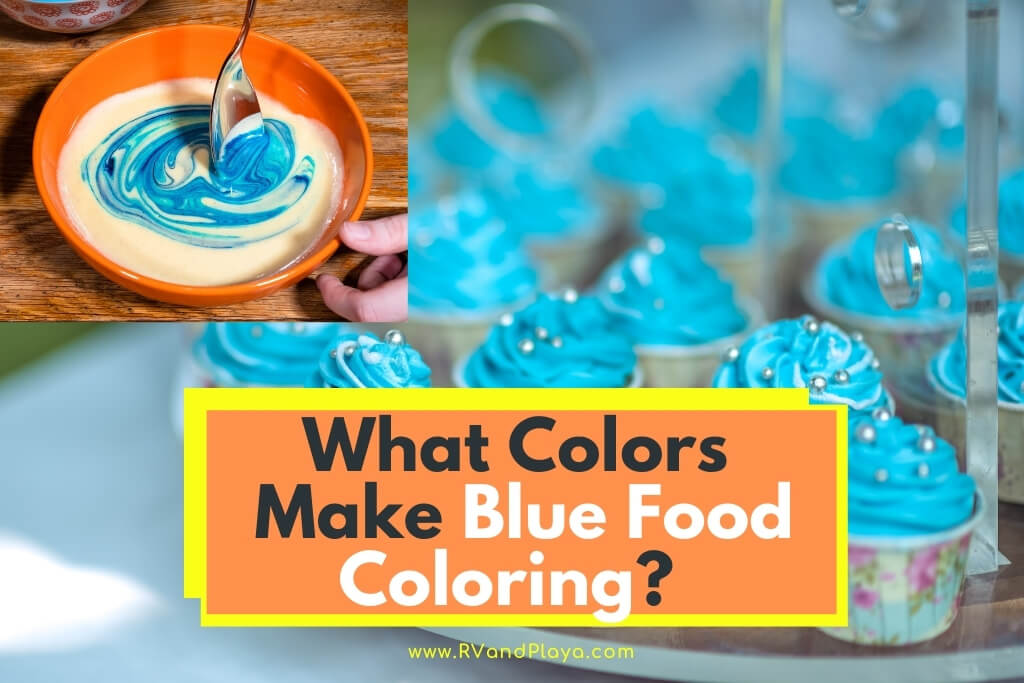Do you know what colors make blue food coloring? this is one of the questions our readers ask a lot. Well, we´ve got you covered.
Food coloring is a fun and—especially during Easter—interactive way to get creative with what we consume. It’s used in a lot of edible applications including egg coloring and various icing designs for cakes and cookies.
But what colors make blue food coloring? Blue food coloring is made with a combination of cyan, magenta, and yellow. You can hold back on the yellow to make darker blue hues while adding more will brighten it up a bit. For just standard blue, cyan and magenta will serve.
Making the color blue is just a matter of mixing the correct food coloring to bring it out. However, you can also make your very own blue food coloring by using the juices from food.
Of course, this also means that you will pass on the flavoring of whatever foods you use.
The best part about using the juices from fruits and vegetables to make food coloring is that it’s both a fun activity—especially if you have kids—and doesn’t cost anything but the price of the food you are going to consume anyway.
Table of Contents
How To Make Blue Food Coloring With Food
First, you’ll need to gather the right ingredients, which would be half a head of red cabbage, water, and baking soda.
It doesn’t take much, and you’ll be using the alkaline properties of the baking soda to turn the red cabbage juice blue.
This also works for purple, depending on how much of each ingredient you decide to use.
- Chop the cabbage into small pieces and remove the stem
- Place the cabbage in a pot and add water until the cabbage is covered
- Raise the temp enough to lightly boil it for ten minutes
- Drain the reddish/purple water into a bowl
- Carefully add baking soda and mix, ½ teaspoon at a time
- Enjoy your freshly made, natural blue coloring
You can also use spinach juice or green tea to mix with the cabbage juice since both are high in alkalinity.
Be careful with the spinach and make sure you’ve strained it well, keeping out the little bits of green so that you have a liquid-only reservoir.
Also, make sure that the cabbage juice has returned to room temperature before adding the baking soda. Baking soda is sensitive to heat and may alter the appearance of the mixture.
If you’re looking to make a more interesting blue, something that really pops, consider adding blueberries and/or black beans to the cabbage as it boils.
The result will be a deeper and more vibrant blue than the kind you get with just red cabbage and baking soda.
You can also get blue dye colorings by just using blueberries. Place them in a blender and once they’ve been well blended, pour them onto a napkin and press the blueberries, straining the juice through the napkin.
It will come out slightly purple in color, however, it dilutes with water as a darker blue, lighter the more water you introduce.
You can also make purple dye in this way, especially if you leave it undiluted or use far more blueberries to the red cabbage boiling mix
How To: Natural Blue Food Coloring with Red Cabbage >> Check out the video below:
Why Is Natural Food Coloring Better Than Artificial?
You should always question anything that’s artificial before you consume it. That’s especially true for artificial food coloring as there’s a very good reason to make your own and stay away from the artificial version.
Many artificial food colorings contain aluminum, barium, and zirconium.
That are three ingredients you probably don’t want floating around in your digestive system before being distributed to areas of the body where they can cause harm.
In years past, the Food and Drug Administration has contracted several studies that have shown potential links between artificial food colorings and mental disorders—behavioral disorders—along with numerous health problems.
Read also: What Do You Get When You Mix Red And Blue?
A study conducted on 200 kids determined that when artificial coloring was removed from diets, the children improved as far as their behavioral problems at school, crankiness, and sleeplessness. It also helped promote alertness in class which, in turn, helps with memory.
According to Eating Well, humans are consuming five times more food dyes than we were over fifty years ago, in 1955.
It’s also linked to increases in Attention Deficit Disorders (ADD).
So, making your own dyes, with natural ingredients, is far more healthy for you and/or your children.
Read also: What Colors Make Navy Blue Icing?
On A Final Note
Making blue dye isn’t a difficult process at all and it doesn’t cost an arm and a leg in terms of food supplies or instruments.
Once you produce the dye, it can be used for so many different things that you’ll wonder why you never thought of it before.
The all-natural method for producing blue dye is much more healthy, especially if you have kids.
It’s a fun activity that avoids the unhealthy aspects of artificial dye and will help you complete your creative projects in a way that’s more fun and healthy for everyone.
Here are some of my favorite services, products, and Stores
There are affiliate links, so if you do decide to use any of them, I´ll earn a small commission. But in all honesty, these are the exact what I use and recommend to everyone, even my own family.
To see all my of most up-to-date recommendations, check out this resource that I made for you!
+ Products & Services
+ Convenience Stores
+ Save Thousands of Dollars
References
https://www.thespruceeats.com/diy-natural-food-dyes-4140390
Recent Posts
Do you know what colors make red food coloring? this is one of the questions our readers ask a lot. Well, we´ve got you covered. Red is a primary color. This means that you cannot simply mix two...
What Colors Make Lavender with Food Coloring? (How To – For Beginners)
Coloring food with Lavendar coloring is a great way to get everyone talking about your delicious food! We know that it can be a bit tricky to get the exact shade you want. So, what colors make...


